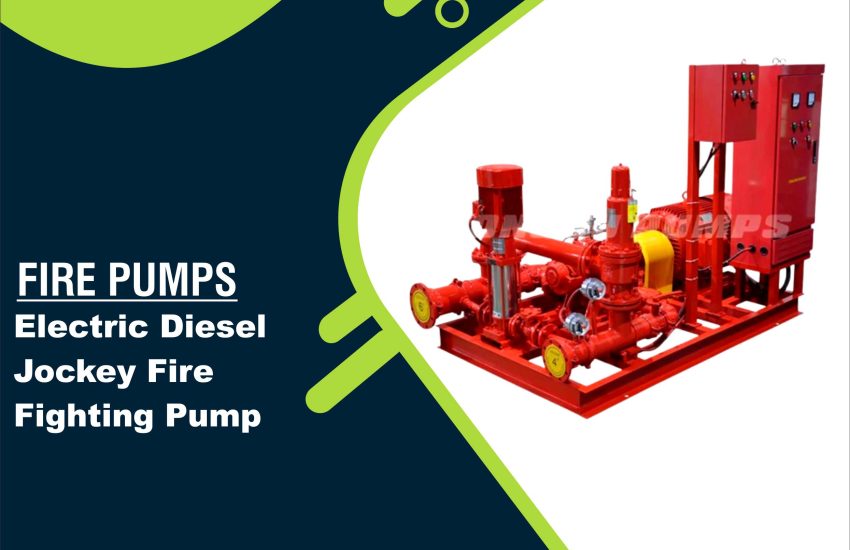Electric Diesel Jockey Fire Fighting Pump plays a crucial role in fire safety systems, ensuring consistent water pressure when needed most. These pumps offer reliable performance across a wide range of applications, from residential buildings to large industrial facilities. In this article, we will explore the service conditions, specifications, and benefits of the Electric Diesel Jockey Fire Fighting Pump to help you choose the right solution for your fire protection needs.
Service Conditions for Electric Diesel Jockey Fire Fighting Pumps
The Electric Diesel Jockey Fire Fighting Pump is designed to operate under specific conditions to deliver optimal performance. Below, we’ll break down the key service conditions that affect its operation.
Atmosphere Pressure
To maintain efficient operation, the pump should function under atmosphere pressure greater than 90 kPa. However, in abnormal conditions, the engine-rated power may decrease. Therefore, a more powerful engine may be necessary to ensure safety and reliable performance under such conditions.
Ambient Temperature
The pump operates best in ambient temperatures ranging from 5°C to 40°C. It achieves its rated power when the ambient temperature is 25°C. It’s important to note that for every 5.6°C rise in temperature, the engine’s rated power will drop by 1%. So, for higher temperatures, you may need to adjust your system accordingly.
Relative Air Humidity
For efficient functioning, the relative humidity should ideally be between 30% and 80%. Humidity levels outside this range can affect the pump’s performance and efficiency, especially in more extreme conditions.
Altitude Considerations
When operating at higher altitudes, the engine’s rated power decreases by 3% for every 100m of elevation. This is a key consideration when installing the pump in mountainous or high-altitude areas. Therefore, be sure to account for this power loss when planning your installation.
Engine Power Requirement
The engine’s rated power must be 10% higher than the pump’s absorbed power to ensure smooth operation and efficiency. Additionally, the real power output of the engine can be calculated using the formula:
Engine Real Power Output = (CA + CT – 1) × Rated Power, where CA and CT are constants based on the environmental conditions.
Types of Electric Diesel Jockey Fire Fighting Pumps
Electric Diesel Jockey Fire Fighting Pumps come in various configurations, each designed for different flow rate and head pressure requirements. Below, we’ll describe the main types and their specifications.
End Suction Fire Pump
- Size: 50-200 mm
- Flow Rate: 36.3 to 400 m³/h
- Head: 5 to 125 m
- Power: 0.22 to 110 kW
The End Suction Fire Pump is ideal for medium flow applications and offers reliable performance for typical fire protection systems. It is particularly suitable for smaller residential or commercial installations.
Multistage Fire Pump
- Size: 40-300 mm
- Flow Rate: 3.75 to 850 m³/h
- Head: 19 to 816 m
- Power: 3 to 1600 kW
The Multistage Fire Pump is designed for high-pressure applications. It is commonly used in tall buildings or industrial facilities where high-pressure water flow is required to combat fires.
Split Case Fire Pump
- Size: 80-450 mm
- Flow Rate: 14.5 to 2500 m³/h
- Head: 6.1 to 200 m
- Power: 2.2 to 1800 kW
The Split Case Fire Pump is built for large-scale applications, where high flow rates are necessary. These pumps are well-suited for large industrial complexes or commercial buildings.
Submerged Fire Pump
- Size: 150-1000 mm
- Flow Rate: 50 to 8400 m³/h
- Head: 15 to 150 m
- Power: 5.5 to 2000 kW
The Submerged Fire Pump is used in installations where the pump is submerged in water. These pumps are ideal for reservoirs or deep-water applications where the pump needs to be submerged below the water level.
How to Select the Right Electric Diesel Jockey Fire Fighting Pump
Choosing the correct Electric Diesel Jockey Fire Fighting Pump depends on a few key factors:
- Flow Rate: Identify the volume of water needed for your firefighting system. The flow rate will vary depending on the size of the property and its firefighting needs.
- Head Pressure: The head pressure is essential to ensure water reaches the appropriate heights, especially in taller buildings or areas with difficult terrain.
- Engine Power: The engine’s rated power should exceed the pump’s absorbed power by at least 10% to ensure optimal performance and avoid overloading.
- Environmental Considerations: Account for factors such as altitude, ambient temperature, and relative humidity that could affect the pump’s performance.
- Pump Type: Choose between the End Suction, Multistage, Split Case, or Submerged fire pump models depending on your flow rate and head pressure requirements.
Advantages of Electric Diesel Jockey Fire Fighting Pumps
- Reliable Performance: These pumps provide consistent water pressure, ensuring your fire protection system is always ready in an emergency.
- Long-Lasting Durability: Built with high-quality materials, Electric Diesel Jockey Fire Fighting Pumps are designed for long-term use and can withstand harsh conditions.
- Energy Efficiency: Diesel engines offer higher energy efficiency compared to electric pumps in high-demand applications, reducing operating costs over time.
- Versatile Applications: Whether you need a low-flow solution for a residential building or a high-capacity pump for an industrial facility, the Electric Diesel Jockey Fire Fighting Pump has you covered.
Conclusion
The Electric Diesel Jockey Fire Fighting Pump is a highly reliable and efficient solution for fire protection systems. With its various configurations—including End Suction, Multistage, Split Case, and Submerged pumps—this system can be tailored to meet the needs of different applications. By considering factors such as flow rate, head pressure, and engine power, you can select the right pump for your system. Overall, the Electric Diesel Jockey Fire Fighting Pump ensures that your fire protection system operates at peak efficiency, providing essential safety when it matters most.


